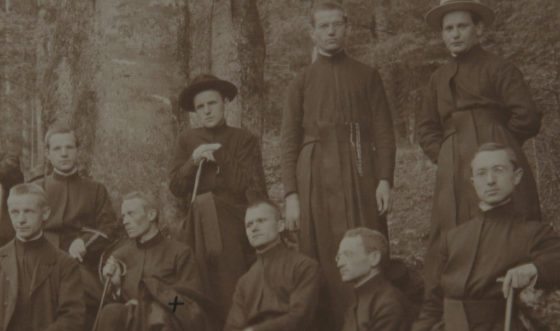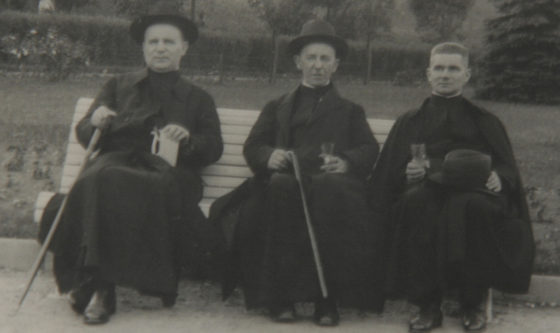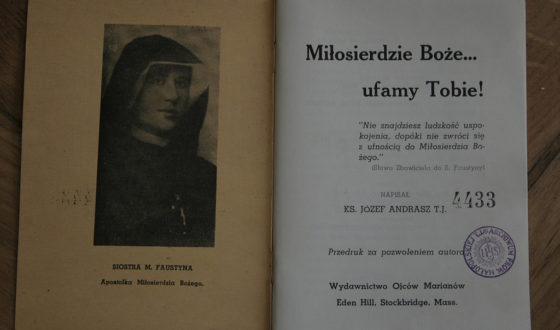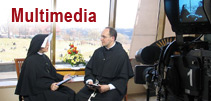Since 1932 Father Joseph Andrasz S.J. was the quarterly confessor of the novitiate of the Congregation of Sisters of Our Lady of Mercy in Cracow-Łagiewniki. However the professed sisters also went to confession to him. For the first time he ministered to Sister Faustina during the retreat before her perpetual vows in April, 1933. He became her permanent spiritual director during the last years of her life, which she spent in Cracow. Father Andrasz ministered to Sister Faustina for over two years and a half altogether and after her death he involved himself in the fulfilment of her mission. Under his direction the Image of the Merciful Jesus, which is nowadays renowned for graces in the Shrine in Cracow – Łagiewniki, was painted by Adolf Hyła. Father Andrasz also initiated solemn services to the Divine Mercy in the monastic chapel of the Congregation in Łagiewniki (1943) as well as celebrating the Feast of Mercy (1944). It was on his initiative that memories of Sister Faustina were gathered, while his booklet “Divine Mercy, we trust in thee”, which promotes the devotion to the Divine Mercy in the forms conveyed by Saint Faustina, has been translated into many languages and a large number of its copies have been sold around the world. He was also the author of the first biographies of the Apostle of the Divine Mercy. A short biographical note was published in the booklet “Divine Mercy, we trust in thee”, while a long biography, which he did not finish, has never been published.
Father Joseph Andrasz was born on 16 October, 1891. He came into the world in a family of ten children, in Wielopole, near Nowy Sącz. Having completed a high school education in Nowy Sącz, at the age of 15 he entered the Society of Jesus and after two years of the novitiate he took his first religious vows. Later he studied philosophy and theology in Poland and in Gräfenberg (Germany) and on his name day, on 19 March, 1919, he was ordained priest by Bishop Anatol Nowak in Saint Barbara’s Church in Cracow. Then he took up the post of a writer at the Jesuits’ Publishing House in Cracow and involved himself in spreading the worship of the Heart of Jesus. On his initiative the book series: “Spiritual Life Library” was created – over 40 volumes of the most outstanding works on asceticism and mysticism were published. Father Andrasz did not write about the spiritual life solely. In his works he also spread the worship of the Heart of Jesus, the Apostleship of Prayer and the Liturgy. His booklet entitled “Together with the Priest”, which familiarized the reader with the riches of the Eucharist, was a bestseller going through as many as 20 editions. In 1930 he became the National Secretary of the Apostleship of Prayer and Family Consecration. He was the head of the works in the dioceses of Cracow and Częstochowa right up until 1953. Father Andrasz’s greatest achievement in this field was the consecration not only of families or parishes but also the whole nation to the Heart of God, which took place on 21 October 1951. From 1923 to 1928 he edited “Our News”, in which he published many articles about history. For 10 years (1930-1940) he was the editor of “Messenger of the Sacred Heart” and for one year (1936-1937) the head of the Apostleship of Prayer Publishing House. Thanks to him a new edition of the “New Testament” translated by J. Wujek was also published. At the same time he was a highly regarded retreat preacher, confessor and spiritual director. Not only did he hear the confessions of Sister Faustina but also of many persons who led a deep spiritual and mystical life, for instance Mother Zofia Tajber, the foundress of the Congregation of the Sisters of the Most Holy Soul of Christ. He was a regular and extraordinary confessor of: the sisters of Nazareth, the Ursulines, the Sacre Coeur sisters, the sisters of Our Lady of Mercy and of many other congregations.
During World War II, when the Jesuits’ College at Kopernika Street in Cracow was transformed into a military hospital by the Germans, Father Andrasz lived in many places; he stayed at the residence of nuns who he served as a priest. In 1942 Mother Superior Irene Krzyżanowska invited him to the convent in Łagiewniki, where he stayed till 1945. Since the Second World War till his death, 1 February 1963, he devoted himself to the apostolate of the Divine Mercy. His body was buried in the Jesuits’ tomb in Rakowicki Cemetery in Cracow.
Actually, Father Joseph Andrasz S.J. was Sister Faustina’s confessor and spiritual director for a period not much shorter than Rev. Michael Sopoćko. He started to do that permanently in May 1936, when she came to Cracow, and served her till the day of her death (5th October, 1938). Before that, she went to confession to him during the retreat preceding the permanent vows in April 1933, and during the one in October 1935, to which she came from Vilnius. All the meetings were important since they pertained not only to her spiritual life but also to the mission entrusted to her by Jesus.
The question of the “new congregation” was the vital issue and Father Andrasz took part in discerning it. In October 1935, Sister Faustina came for the retreat in Cracow and for the first time he heard about it. From the beginning he claimed that the very idea of a congregation that would preach and obtain the Divine mercy for the world was good and necessary for the Church. However, he advised her to be prudent, to pray and offer sufferings for that intention so that the idea was discerned well. At that time he told Sister Faustina that for the time being what she was speaking about was only a glimmering of a project, that’s why she was to wait till God’s will was clearer.
When Sister Faustina came to Cracow to stay there permanently, the idea of the new congregation came back more strongly. Then she felt a very strong urgency within herself to leave her Congregation and start founding a new one. One episode which Sister Faustina writes about in her “Diary” depicts Father Andrasz’s spiritual direction perfectly: Right after her arrival to Cracow she told him about the urgency she felt to leave her Congregation and to found a new one. Father Andrasz advised her to pray for that intention till the day of the Feast of the Most Sacred Heart and add some mortification to the prayer. He said that on that day he would give her an answer. However, one day Sister Faustina heard Jesus’ words: “Do not be afraid of anything, I am with you” (Diary 655) and after these words she felt such urgency that she did not want to wait till the day of the Feast of the Sacred Heart any more. During the first confession after she heard the words she told Father Andrasz that she was going to leave the Congregation. Father Andrasz replied: “Sister, if you have made the decision on your own, then you alone will take the responsibility for it, so leave if you wish” (Diary 655). At the beginning Sister Faustina was happy that Father Andrasz had given her a free rein but on the following day a great darkness came over her soul, therefore, she postponed what she had decided to do. Father Andrasz explained that the darkness was not necessarily an obstacle to action, however, he told her to consult Rev. Sopoćko about this issue. So, Father Andrasz let her have a lot of freedom. He neither blocked nor rejected her inspirations. He did not make decisions instead of her, yet he accompanied her, helped her to discern the work of God. He saw to it that she did not go astray, advised her to pray and offer mortifications for the intention so that he was able to discern this work well.
Cooperation
Father Andrasz appreciated Rev. Sopoćko’s spiritual direction a lot. He frankly told Sister Faustina to seek advice from the Vilnius spiritual director precisely on this difficult matter pertaining to the idea of the new congregation and the advice was very important to him. He said to Sister Faustina: “You have really been blessed with a wise and holy spiritual director, a truly providential man; be thankful to God for him” (Letter 56). He told Sister Faustina to inform her spiritual director from Vilnius of important matters, which she did by writing letters to him.
Rev. Sopoćko also held Father Andrasz in high esteem. In his letters to Sister Faustina he told her to inform Rev. Sopoćko about all matters, sincerely, including inner impulsions, and to be obedient to him in everything. In one of his letters he wrote: “In accordance with God’s will, you currently have your own director in Cracow, in whom you should confide everything” (Letter 49). As regards the question of Sister Faustina’s leaving the Congregation and founding a new one he was more cautious than Father Andrasz. In his opinion, since the spiritual director from Cracow neither forbade nor allowed her to leave the Congregation clearly, it was not right for Sister Faustina to make the decision herself and act on her own. All the time he obliged her not to take any action without Father Andrasz’s permission and he promised to pray for him so that he was granted God’s light to discern this matter.
The fact that Rev. Sopoćko and Father Andrasz respected and trusted each other was not only highly beneficial to Sister Faustina’s spiritual life but also helped her to discern and fulfil the mission entrusted to her by Jesus. Sister Faustina noticed that herself and in the letters to Father Sopoćko she not only expressed her gratitude to God for the spiritual directors but she also wrote that the manner in which they directed her soul was the same. “With reference to my confiding entirely in Father Andrasz, I faithfully do this and I am obedient to him in everything; I do not have any difficulties in this respect because Father Andrasz’s conduct towards my soul does not differ in any way from your conduct towards me, Father” (Letter 56).
Friend of the Heart of Jesus
Sister Faustina not only wrote how she herself appreciated the ministry of the spiritual director from Cracow but also what Jesus and the Mother of God said about him. She herself thought that Father Andrasz was a great grace for her. In Sister Faustina’s opinion he was a help to discern God’s work in her soul as well as the inspirations pertaining to the fulfilment of the mission of Mercy. She called him “a spiritual leader”, “a pillar of light” that lit her way to close union with God and she regretted that there were so few such priests. She wrote that this was a priest filled with the spirit of God, a holy and an enlightened man. Sister Faustina came to know how very pleasing he was to God and she had respect for him, as for a saint. Every day after Holy Communion she thanked Jesus for the priest and asked for the light of the Holy Spirit for him so that he could discern God’s plans for her well.
In the “Diary” she also wrote what Jesus said about Father Andrasz. He called him a friend of His Heart, His representative, a veil behind which He was hiding. He told Sister Faustina that He had chosen him Himself so that she did not go astray. He told her that he spoke through his lips and that his word was God’s will for her. “Be sure in the depths of your soul – said Jesus to Sister Faustina – that I speak through his mouth, and I want you to open up your soul to him as simply and as sincerely as you do to Me. Once again I say to you, My daughter, know that his word is My will for you” (Diary 979). The moment when Sister Faustina felt most that Jesus identified Himself with Father Andrasz was when she was ill in hospital and cried because she had not been able to go to confession for three weeks. Then Father Andrasz came into her room and, without saying a word, sat down to hear her confession. Sister Faustina said about everything that weighed upon her heart with great ease and when he was imposing a penance on her and giving her absolution she saw that it was not Father Andrasz but Je- sus Himself. At the end of the story she wrote that Jesus heard confessions in the same way that priests did.
In the “Diary” Father Andrasz is also present in the context of the Mother of God apparitions. When she had one of her visions, during a Mass, Sister Faustina saw the Mother of God with the Infant Jesus. Before the Elevation the Infant Jesus ran with joy to the centre of the altar and later He let Father Andrasz consume Him. The Mother of God said to Sister Faustina: “Look how confidently I entrust Jesus to his hands; you, too, should entrust your soul to him and be like a child with respect to him” (Diary 677).
Apostolate of Mercy
After Sister Faustina’s death during World War II, Father Andrasz involved himself in the mission of his great penitent. The fact that since 1942 he lived in the convent of the Congregation of the Sisters of Our Lady of Mercy in Cracow-Łagiewniki helped him to do so. During that time Adolph Hyła came to the convent and proposed to paint a picture for the chapel. His family had been rescued during the war and he wanted the picture to be his votive offering for that. Mother Superior, Irene Krzyżanowska, consulted Father Andrasz about it and asked Adolph Hyła to paint an image of the Merciful Jesus according to Sister Faustina’s vision. The painter received a reproduction of a replica of the first picture painted by Kazimirowski in Vilnius as well as the description of the image in Sister Faustina’s “Diary”. On 7 March 1943 Father Andrasz blessed the first picture of the Merciful Jesus painted by Adolph Hyła. The chronicler of the house in Cracow described the ceremony fairly accurately. Not only all the sisters but also the wards took part in it with great joy and in his sermon Father Andrasz said that he had not expected that Sister Faustina’s mission would be fulfilled so quickly. When she told him about a picture of Divine Mercy he did not imagine that he would bless it in such a short time.
On the first Sunday after Easter, on 16 April 1944, Father Andrasz also blessed the second image painted by Hyła, the size and shape of which matched the alcove of a side altar. It is also worth mentioning that the picture looked a bit different than now as there was the landscape of Łagiewniki in the background, which resulted from the interpretation of the image presented to the painter by Father Andrasz. In his opinion, the painting portrayed the Merciful Jesus walking on the Earth in order to heal seriously ill humankind and to pour out His mercy, symbolized by the rays, upon human souls. His gaze is full o f mercy, like the one from the cross and one hand is raised in the gesture of blessing all of those that recourse to His mercy. Rev. Michael Sopoćko did not agree with this interpretation of the picture. In his opinion, the theological meaning of the image was strongly connected with the liturgy of the first Sunday after Easter and with John’s Gospel, which depicts the apparition of the risen Lord in the Cenacle and the institution of the sacrament of Reconciliation. Therefore, in 1952 Hyła painted out the landscape of Łagiewniki, put the figure of Jesus against a dark background and painted a floor beneath His feet. This picture was the fulfilment of the words that Jesus said to Sister Faustina during His first revelation: “I want this picture venerated first in your chapel, and in the whole world” (Diary 47) and it was Father Andrasz who played a substantial part in making His wish come true. Nowadays the picture from Cracow-Łagiewniki is the best-known image of the Merciful Jesus.
Thanks to Father Andrasz solemn services to the Divine Mercy started to be conducted in the monastic chapel in Łagiewniki every third Sunday of the month. The inhabitants of Cracow and the neighbouring area took part in them in great numbers because the times were hard and it was the Divine Mercy that the people sought hope and rescue from. It should be emphasized that Father Andrasz was very courageous and his courage stemmed from his deep conviction that the Divine Mercy, which saves man and the world, should be worshipped. During the war Sister Faustina’s spiritual director from Cracow conducted the services and gave sermons himself. Later other priests from Cracow, including the young Rev. Karol Wojtyła, also celebrated the services.
In 1944 in Łagiewniki the first Sunday after Easter was solemnly celebrated as the Feast of Mercy for the first time. It was also thanks to Father Andrasz, who thought that the Church needed such a feast very much. He pointed out that the Church had already introduced new feasts inspired by private revelations, for instance, Corpus Christi, the Feast of the Most Sacred Heart, the Feast of Christ the King or Mary’s feasts. However, he was realistic and knew that the process would be long and difficult, therefore, he advised her to be patient. He talked with Primate Cardinal August Hlond, who assured him that the Vatican Congregation took care of the matter. So it can be said that it was thanks to Sister Faustina’s confessor from Cracow that the Divine Mercy started to be worshipped in Łagiewniki. During the Second World War already because of Father Andrasz the convent in Łagiewniki became a thriving centre from which the message of Mercy was spread.
Father Andrasz had a lot of experience with publishing, he knew how highly significant testimonies from eyewitnesses were and it was on his initiative that memoirs of those that had known Sister Faustina started to be collected. Mother General asked sisters in the whole Congregation to write down what they remembered about her and, right after the war, Sister Barnarda Wilczek went where Faustina had come from, to her home and places where she had worked as a servant, in order to note down what was said about her. At Father Andrasz’s request Rev. Sopoćko also wrote such a memoir. Thanks to Father Andrasz’s initiative we have quite a lot of them in the archive. Some have been published in the quarterly “Divine Mercy Newsletter” already.
“Divine Mercy… we trust in Thee”
Father Andrasz’s small booklet entitled “Divine Mercy… we trust in Thee” has played an invaluable role in spreading the message of Mercy. Thanks to it a large number of people around the world have come to know about Sister Faustina and her mission. The first edition was published in 1947 in Poland and sold out very fast. The second one was prepared in 1948 and all the booklets were confiscated by the Provincial Office for the Control of the Press and Events in Cracow. However, the ban on distributing the booklet in Poland, introduced by the Polish state, did not destroy the work as it was sold around the world. At first the Marians published the booklet in English in the USA and, later, strongly committed to spreading the worship of the Divine Mercy in the forms conveyed by Sister Faustina, they distributed it also in Canada, Australia, New Zealand, Asia and Africa. The booklet, translated into Spanish, was published with the Imprimatur of the local bishops and a large number of its copies were distributed in the countries of Latin America, mainly in El Salvador, Colombia, Ecuador, Chile, Mexico, Argentina, Uruguay, Peru and Guatemala. In the Portuguese language it was distributed in Brazil, and in Europe it was translated and published in German, Italian, Spanish and Portuguese. Father Andrasz was delighted that the work was so popular; he was happy because it became a tool thanks to which so many people could come to know the message of Mercy conveyed by Sister Faustina.
Sr. M. Elisabeth Siepak ISMM
Translated by
Iwona Franceschini






















